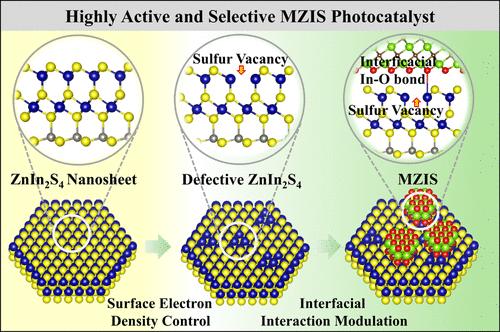当前位置:
X-MOL 学术
›
ACS Catal.
›
论文详情
Our official English website, www.x-mol.net, welcomes your
feedback! (Note: you will need to create a separate account there.)
Reactive Oxygen Species-Mediated Photooxidation in a Full-Space Electric Field Catalyst: Selectivity and Activity Control of Intramolecular Alcohol Hydroxyl and Aldehyde Groups
ACS Catalysis ( IF 11.3 ) Pub Date : 2024-11-15 , DOI: 10.1021/acscatal.4c04687 Yi-Wen Han, Yu-Ting Chu, Lei Ye, Tian-Jun Gong, Yao Fu
ACS Catalysis ( IF 11.3 ) Pub Date : 2024-11-15 , DOI: 10.1021/acscatal.4c04687 Yi-Wen Han, Yu-Ting Chu, Lei Ye, Tian-Jun Gong, Yao Fu

|
The rational design of nanocatalysts with high activity and selectivity is crucial for photocatalytic selective oxidation, where reactive oxygen species (ROS) serve as the key oxidants for inducing molecular catalytic behavior. We developed a defective ZnIn2S4/Ti3C2 Schottky junction featuring a full-space electric field by chemically anchoring Ti3C2 nanoparticles onto the defects of a ZnIn2S4 nanosheet via the defect-mediated heterocomponent anchorage approach, as a photocatalyst platform for manipulating the efficient and alternative ROS generation (•OH or •O2–) to controllably oxidate the intramolecular alcohol hydroxyl or aldehyde group toward tunable oxygenates. The full-space directionally aligned electric field creates asymmetrical charge distributions, facilitating charge carrier localization and delocalized electron transportation, ultimately leading to an order of magnitude increase in ROS concentration for superhigh activity. Meanwhile, due to their thermodynamic and kinetic advantages under different atmospheres, hydroxyl radicals preferentially activate alcohols and induce two consecutive dehydrogenation reactions, whereas superoxide radicals preferentially activate aldehydes and induce oxygen insertion processes, thereby achieving selectivity control of the products. Encouragingly, several compounds with alcohol hydroxyl and aldehyde groups are compatible using the current protocol. This work provides a paradigm for programmable construction of composite photocatalysts in selective oxidation, elucidating the substantial impact of ROS generation (concentrations and types) on the efficient oxidation of specific functional groups.
中文翻译:

全空间电场催化剂中活性氧介导的光氧化:分子内醇羟基和醛基的选择性和活性控制
具有高活性和选择性的纳米催化剂的合理设计对于光催化选择性氧化至关重要,其中活性氧 (ROS) 是诱导分子催化行为的关键氧化剂。我们通过缺陷介导的异质组分锚定方法将 Ti3C2 纳米颗粒化学锚定到 ZnIn2S4 纳米片的缺陷上,开发了一种具有全空间电场的缺陷 ZnIn2S4/Ti3C2 肖特基结,作为光催化剂平台,用于操纵高效和替代 ROS 的产生(•OH 或 •O2–) 可控地将分子内醇羟基或醛基氧化为可调含氧化合物。全空间方向对齐的电场产生不对称的电荷分布,促进电荷载流子定位和离域电子传输,最终导致超高活性的 ROS 浓度增加一个数量级。同时,由于羟基自由基在不同气氛下的热力学和动力学优势,羟基自由基优先活化醇类并诱导两次连续的脱氢反应,而超氧自由基优先活化醛类并诱导氧插入过程,从而实现对产物的选择性控制。令人鼓舞的是,几种具有醇羟基和醛基的化合物在使用当前方案时是兼容的。这项工作为选择性氧化中复合光催化剂的可编程构建提供了一种范式,阐明了 ROS 生成(浓度和类型)对特定官能团有效氧化的重大影响。
更新日期:2024-11-16
中文翻译:

全空间电场催化剂中活性氧介导的光氧化:分子内醇羟基和醛基的选择性和活性控制
具有高活性和选择性的纳米催化剂的合理设计对于光催化选择性氧化至关重要,其中活性氧 (ROS) 是诱导分子催化行为的关键氧化剂。我们通过缺陷介导的异质组分锚定方法将 Ti3C2 纳米颗粒化学锚定到 ZnIn2S4 纳米片的缺陷上,开发了一种具有全空间电场的缺陷 ZnIn2S4/Ti3C2 肖特基结,作为光催化剂平台,用于操纵高效和替代 ROS 的产生(•OH 或 •O2–) 可控地将分子内醇羟基或醛基氧化为可调含氧化合物。全空间方向对齐的电场产生不对称的电荷分布,促进电荷载流子定位和离域电子传输,最终导致超高活性的 ROS 浓度增加一个数量级。同时,由于羟基自由基在不同气氛下的热力学和动力学优势,羟基自由基优先活化醇类并诱导两次连续的脱氢反应,而超氧自由基优先活化醛类并诱导氧插入过程,从而实现对产物的选择性控制。令人鼓舞的是,几种具有醇羟基和醛基的化合物在使用当前方案时是兼容的。这项工作为选择性氧化中复合光催化剂的可编程构建提供了一种范式,阐明了 ROS 生成(浓度和类型)对特定官能团有效氧化的重大影响。


















































 京公网安备 11010802027423号
京公网安备 11010802027423号